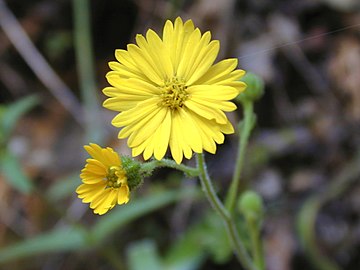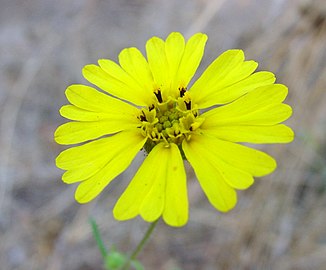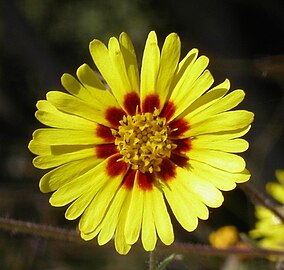Madia elegans

| Madia elegans | |
|---|---|
 | |
| Long-horned bee on flower head | |
| Scientific classification | |
| Kingdom: | Plantae |
| Clade: | Tracheophytes |
| Clade: | Angiosperms |
| Clade: | Eudicots |
| Clade: | Asterids |
| Order: | Asterales |
| Family: | Asteraceae |
| Genus: | Madia |
| Species: | M. elegans |
| Binomial name | |
| Madia elegans | |
Madia elegans is an annual herbaceous plant species in the family Asteraceae. It is generally known as the common madia, but there are several subspecies known by various common names.[1]
Description
[edit]Madia elegans is covered with short, stiff hairs. Glands are borne on stalks, especially near the flowers.[1] The showy flower varies in appearance across subspecies and even within subspecies. The leaves grow to 20 centimetres (8 inches) in length.[2] Blooming between April and October, several strongly scented, uncrowded, bright yellow daisy-like flower heads grow at the end of a slender green stem, each typically 3–5 centimetres (1+1⁄4–2 inches) wide.[2][3] The flower has numerous thin ray flowers, which close at night,[2] and several central disk flowers. It may be solid lemon yellow or have a maroon center.[2] Its fruits are achenes.
- Growth with maroon-centered flower heads; Oregon
- Stems and flowers; Santa Cruz Mountains, California
- Flower head; Santa Monica Mountains, California
- Flower head with maroon center; San Joaquin County, California
- Flower head; Josephine County, Oregon
Taxonomy
[edit]Subspecies
[edit]- Madia elegans densifolia - showy tarweed
- Madia elegans elegans - common madia
- Madia elegans vernalis - spring madia
- Madia elegans wheeleri - Wheeler's tarweed
Etymology
[edit]The foliage of species in the genus has sticky hairs, hence the common name tarweed.[2]
Distribution and habitat
[edit]The plant is native to western North America from south-central Washington state to northern Baja California.[3][1][4][5] It may be found in dry open forest, disturbed areas and grasslands from low to high elevations.[3]
Uses
[edit]The achenes were historically used as food by Native Americans, including the Pomo and Miwok, who baked them or ground them into flour.
References
[edit]- ^ a b c Giblin, David, ed. (2015). "Madia elegans". WTU Herbarium Image Collection. Burke Museum, University of Washington. Retrieved 2015-01-17.
- ^ a b c d e Spellenberg, Richard (2001) [1979]. National Audubon Society Field Guide to North American Wildflowers: Western Region (rev ed.). Knopf. p. 387. ISBN 978-0-375-40233-3.
- ^ a b c Sullivan, Steven. K. (2015). "Madia elegans". Wildflower Search. Retrieved 2015-01-17.
- ^ "Madia elegans". PLANTS Database. United States Department of Agriculture; Natural Resources Conservation Service. 2015. Retrieved 2015-01-17.
- ^ Hogan, C. Michael (curator). "Madia elegans". Encyclopedia of Life. Retrieved 2015-01-18.
External links
[edit] Media related to Madia elegans at Wikimedia Commons
Media related to Madia elegans at Wikimedia Commons Data related to Madia elegans at Wikispecies
Data related to Madia elegans at Wikispecies- Jepson Manual Treatment: Madia elegans
- U. of Michigan Ethnobotany: Madia elegans
- Madia elegans — CalPhotos gallery




